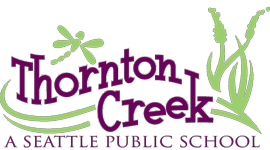Creative Approach
Creative Approach
Welcome to the Thornton Creek Elementary School! We are a Pre-K-5 Option school in the Seattle Public School system. Some of the educational practices that make Thornton Creek a unique learning environment are described below.
Expeditionary learning
Our school’s pedagogy is based on expeditionary learning, a proven model for comprehensive school reform based on the framework of Outward Bound.
Expeditionary learning emphasizes learning by doing, with a particular focus on character growth, teamwork, reflection, and literacy. Teachers connect high-quality academic learning to adventure, service, and character development through a variety of student experiences, including interdisciplinary, project-based learning expeditions. Expeditions draw together personal experience and intellectual growth to promote self-discovery and construct knowledge. More information about expeditionary learning, including ten guiding principles, can be found on the EL Education website.
We believe expeditionary learning harnesses the natural passion to learn and is a powerful method for developing the curiosity, skills, knowledge, and courage needed to imagine a better world and work toward realizing it.
The following are examples of expeditions undertaken at our school:
- Are People Like Bugs? (K)
- Birds of Green Lake (1st)
- Salmon in the Trees (2nd)
- People of the Cedar (3rd)
- Inventors and Inventions! (4th)
- The Human Body (5th)
Wired for Reading® is a word study program developed by Laura Rogan. It provides excellent strategies for demystifying the structure of words, enabling students to read and spell more comfortably and accurately. Research shows that the easier it is for students to read and spell, the freer their minds are to reflect upon the content of the text. This program supports our philosophy of creating lifelong readers and writers. Please note that Thornton Creek uses many aspects of the Wired For Reading ® program, not the entire curriculum.
Social-emotional learning
Social skills are essential to building strong community—one of Thornton Creek’s core values. All of our teachers use the Responsive Classroom framework (described further under “Classroom structure”). Its first guiding principle is that social-emotional learning is as important as academic learning.
As a way to practice social-emotional learning and to strengthen our community, students in classrooms from across grades are “buddied” up with each other: Kindergartners are assigned 5th grade buddies, 1st graders are assigned 3rd grade buddies, and 2nd graders are assigned 4th grade buddies. The older buddies mentor the younger ones, socially and academically, on a weekly basis during school hours.
Physical activity
Thornton Creek students get plenty of opportunities for physical activity during the school day. In addition to three daily outdoor recesses (rain or shine!), they have twice weekly physical education classes. In PE, students work on cardiorespiratory fitness, flexibility, muscular strength, and endurance through various games, basic locomotor movements, and introductory sports skills. They also learn sportsmanship, cooperation, teamwork, and peer encouragement. They practice awareness of self and others (personal and general space).
Classroom structure
Responsive classroom framework
All of our teachers have been trained in and use the Responsive Classroom framework. Its guiding principles stress the importance of social-emotional learning as a means for students’ personal and academic growth; the need for teachers to know their students and how they learn; and how home-to-school as well as staff-to-staff connection fosters a strong community. Learn more about Responsive Classrooms.
Looping
Thornton Creek has adopted a “looping” model of classroom instruction for grades 2–5. Looping means that teachers stay with a class of students for two grades, then “loop” back for a new class. Students remain (for the most part) with the same group of classmates, which strengthens cooperative learning. The advantages of this model are:
- Enables teachers to understand each student’s learning style and offer appropriate instruction.
- Strengthens sense of community and familiarity within the classroom.
- Encourages communication from student to teacher, teacher to student, and student to student.
Student placement
Staff consider a variety of factors when placing students in classes. Our process aims to create classrooms that balance individual and group learning strengths, social needs, relationships within a class group, individual student learning challenges, ethnic diversity, and gender balance. In addition, staff receive input from new families.
